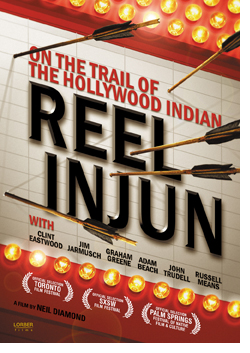 Film: Reel Injun (National Film Board of Canada)
Film: Reel Injun (National Film Board of Canada)
Directors: Neil Diamond, Catherine Bainbridge, Jeremiah Hayes
Cast: Starring Chris Eyre as himself, with interviews with Clint Eastwood, Jim Jarmusch, Robbie Robertson, Sacheen Littlefeather, John Trudell, Russell Means
Genre: Documentary
(Watch the film online here.)
Bury My Heart in the Hollywood Hills
?I remember once we were on a set, the director said ?I want a real native, upfront. I want to see the real thing.? We couldn’t find one!?
Clint Eastwood, as quoted in Reel Injun
We once had a cat who was such a gifted hunter that she eventually got bored with mice and rats and turned to bigger prey, like squirrels and weasels. One evening she brought home a bat. She hadn’t quite killed it because she wanted us to see how frightening this creature was as it hissed, flapped, and writhed on the floor. She would glance at it every now and then and then stare up at us, purring happily, as if to say, ?Look at this terrifying thing I caught!?
There’s a malicious tendency in Hollywood films to glamourize Native Americans in order to inflate our own colonialist egos, presenting them as either a fearful threat or a stylized ideal. Putting Native Americans at the center of our Campbellian hero’s tale has done them a terrible disservice and contributes to the social and economic problems they’re still experiencing. It’s little wonder that they’ve consciously rejected the image portrayed in films and television and are now developing their own films about their own realities.
There’s a scene in Smoke Signals in which three Indians are watching a Western shoot-?em-up. ?You know, the only thing more pathetic than Indians on TV,? remarks Thomas-Builds-the-Fire, ?is Indians watching Indians on TV.?
The strange loop caused by Hollywood’s century-long depiction of Native Americans and their resulting self-perception is given careful examination in Reel Injun. But another dimension is present that one doesn’t often encounter, and that is what the Indian symbolizes in Western culture and how this symbol develops in response to changing cultural tides.
The title of the film sums it up, making a pun out of the quest for authentic ?Indianness,? which is carefully staged and then spit out as celluloid. In the end, Native American identity is crucified by Hollywood’s power to define what it means to be Indian.
The mythical struggle between white cowboys and Indian attackers lies at the very heart of Western pop culture and has informed and inspired high culture as well. The ?look? of the Indian was carefully contrived, with the dress of the Plains Indian generalized to all tribes. The white cowboys were good; the Indians, though a terrifying and formidable opponent, were bad, representing the shadow side, the great untamed. Even little white and Indian children got that?there often would be prepubescent fistfights outside the cinemas after the cowboy movies let out.
But Indians also represented a rich world of fantasy, an idealized world of make-believe that would have those same little pugnacious white boys happy to assign their cabins the names of Indian tribes at summer camp. In the ?60s, Native American identity was co-opted by white young people who wanted to ?get back to the garden? and embrace more primal?and thus supposedly more liberating?lifestyles. The Indian was wild and free and uninhibited; he had great skill as a warrior, and the beauteous adventures of his life were the stuff of dreams. Wherever people longed for freedom from social constraints, the Indian archetype wasn’t far behind.
Sadly, an overemphasis on the mythic qualities of the noble pre-colonial savage tended to correlate with attempts to extinguish them. (we’re going to destroy these people, but here are some nice stories to help you remember them.) The ideal could easily be set aside long enough to justify the genocide. The more cunning and superhuman the Indians, the more easily could John Wayne insult them, kill them, and desecrate their graves.
Cree filmmaker Chris Eyre set out ?on a journey to find my Hollywood roots,? as he puts it. The film image of the Indian defines, like it or not, the Indian archetype, and this fantasy, as Adam Beach points out, is pretty much indispensable to our culture. But what does this mean for Indians in search of their true selves?
The movies have for the most part done a lousy job at negotiating reality for generations of Native Americans, but now at last Indians are at the cultural negotiation table, contributing honest, authentic films about their real existence and their own interpretations of their own myths. And the work they’re producing is amazingly good.
It’s a good sign.
Reel Injun manifests eight of the Mindful Bard’s criteria for films well worth seeing: 1) it is authentic, original, and delightful; 2) it poses and admirably responds to questions that have a direct bearing on my view of existence; 3) it stimulates my mind; 4) it harmoniously unites art with social action, saving me from both seclusion in an ivory tower and slavery to someone else’s political agenda; 5) it is about attainment of the true self; 6) it inspires an awareness of the sanctity of creation; 7) it displays an engagement with and compassionate response to suffering; and 8) it makes me appreciate that life is a complex and rare phenomenon, making living a unique opportunity.
Wanda also penned the poems for the artist book They Tell My Tale to Children Now to Help Them to be Good, a collection of meditations on fairy tales, illustrated by artist Susan Malmstrom.


